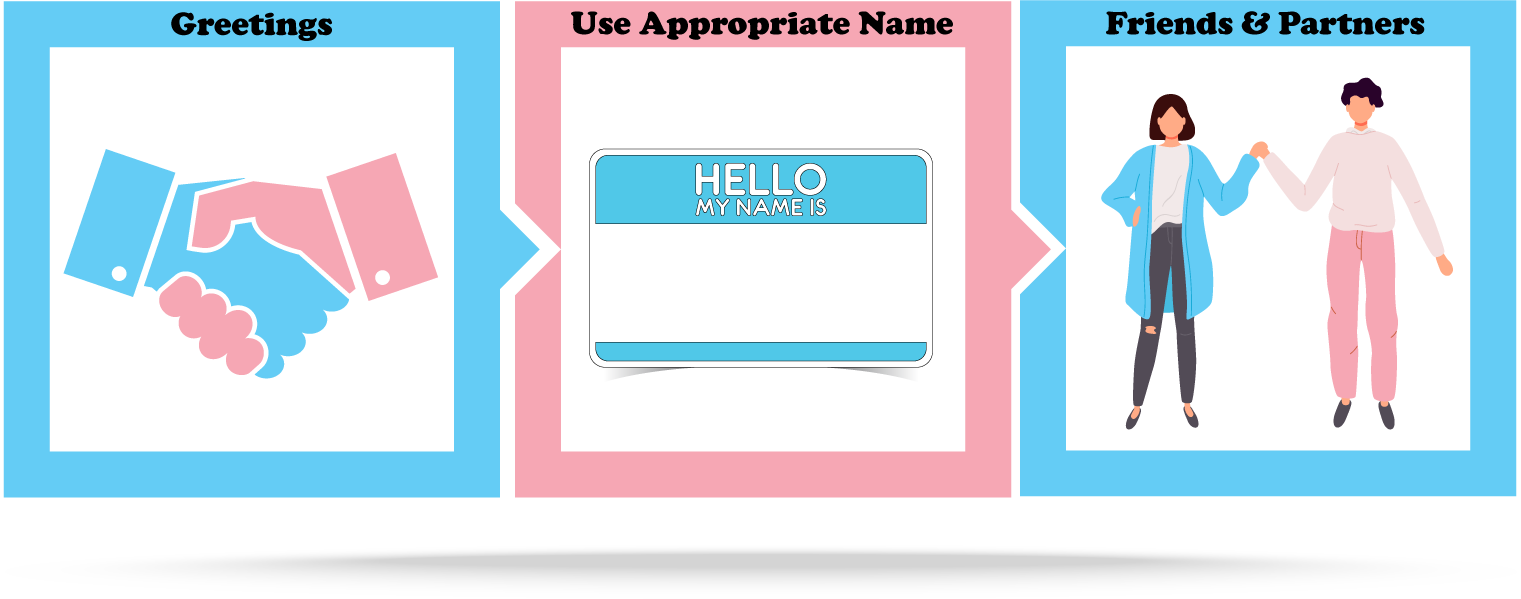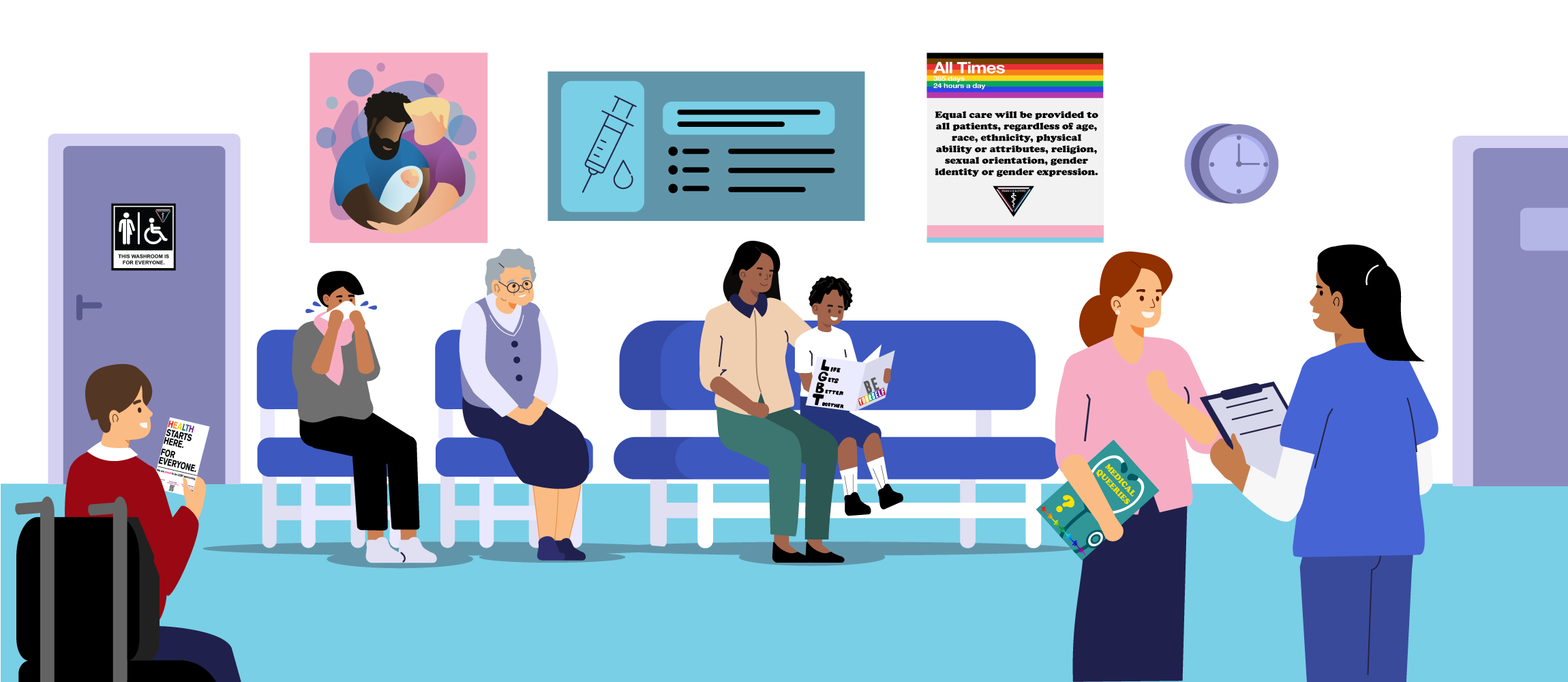
Creating a Safe Clinical Environment
Many LGBTQ+ people have experienced rejection and stigmatization due to their gender identity or sexual orientation in the hands of healthcare providers. They are looking for subtle signs in the medical environment that can be read as indications of whether they are welcomed or not. After effectively training your staff in LGBTQ+ care, making a few adjustments to the space in which you practice can communicate to your LGBTQ+ patients that you welcome them and want them to feel comfortable.
How People Should Be Treated When They Come to Clinic
Greetings
The first contact patients have with staff and how they are greeted at your practice can make a strong impression. If they feel seen and welcomed, they are more likely to relax and to provide accurate information about themselves and their lives.
Use Appropriate Name
When patients come to the front desk to check in, it is important to pay attention to the cues they provide. If a patient says something like “Hi, I’m Y. I’m here to see Dr. X,” the receptionist can see immediately if the name the patient uses is the same or different from the name on the schedule. Either way, we encourage you to make it standard policy for the receptionist to ask the patient if the name on the file is the name s/he/they is correct.
This not only provides an opportunity for transgender patients who have not yet legally changed their names to provide the name they now use, but also allows all patients to indicate if they prefer to be called by something other than their full, legal name. It is also important to train front line staff to understand that it’s entirely okay to have a different name on file, and that they are there to get it right and support the person in front of them.
Friends & Partners
When patients bring someone with them to an appointment, it is important to show respect for both the accompanying person and the relationship the patient has with that person. Allowing the patient to define relationships and determine the role others play in the interaction demonstrates respect for the patient’s identity and relationships and can avoid awkward and uncomfortable situations.
Rather than assuming that you know what the relationship, we suggest you and your staff ask the patient. It is easy enough to ask, “Who have you brought with you today?” which allows the patient to tell you about the person and their relationship. You can then ask whether the patient wants the other person to remain in the waiting room or accompany the patient into the exam room. If they come alone, another way to ask about relationships could be, “Who are your main supports in your life?” as a less invasive way of finding out more about your patient.
Experiences of LGBTQ+ in Healthcare
LGBTQ+ people experience many forms of discrimination in healthcare because of their sexual orientation (lesbian, gay, and bisexual people) and/or their gender identity (transgender people).
LGBTQ+ Canadian women experience disproportionate rates of breast cancer (1). LGBTQ+ Canadians are less likely to have a family doctor and more likely to develop chronic health conditions, poor mental health, and alcohol or drug dependency disorders (2,3). They are less likely to seek medical attention when they feel unwell and more likely to smoke cigarettes, experience homelessness, live in poverty, and experience isolation as seniors (2). American literature has similarly revealed profound disparities in LGBTQ+ healthcare (4).
Creating and broadly communicating a patient non-discrimination policy that includes both “sexual orientation” and “gender identity or expression” is a crucial step in ensuring equitable, high-quality care for LGBTQ patients. It sends an important message to patients and employees alike: LGBTQ+ people must receive equal treatment (5).
Each medical facility in Ontario has a responsibility under the Ontario Human Rights Code to prevent harassment and discrimination, to ensure that all individuals within a workspace have equal opportunities and are treated with respect and dignity, and must establish a process for handling complaints of harassment and discrimination.
Photographs
If you have photos of families on your walls, make an effort to include photos that portray same-sex couples and single parent families. This helps to communicate that you recognize and celebrate a range of diverse family types.
Books & Magazines in Clinic Waiting Areas
When choosing magazines or books to place in your waiting room, consider including one or more titles that reflect an LGBTQ+ audience or deal with LGBTQ+ health-related themes.
Posters & Brochures
Patients want to feel welcomed and represented in your workplace. When choosing medical posters or brochures to keep in your office for patients, consider including one or more that reflect the LGBTQ+ population or issues of particular relevance to this community.
Ensure that there are medically relevant brochures regarding age-appropriate screening and healthy ageing.
Patient Non-Discrimination Policy
Most medical practices have some form of a patient non-discrimination policy. If you do not currently have one at your practice, we suggest you adopt an inclusive policy. If you do have one, check the policy to ensure that it protects gender identity, gender expression, and sexual orientation.
Here is an example of an inclusive policy:
“Equal care will be provided to all patients, regardless of age, race, ethnicity, physical ability or attributes, religion, sexual orientation, gender identity or gender expression.”
Make this policy visible at your workplace. This clarifies that your practice wants LGBTQ+ patients (and all patients) to feel comfortable and fosters an expectation of respect, courtesy, and inclusivity in your clinic environment.
References:
Canada, Parliament, House of Commons, The Health of LGBTQIA2 Communities in Canada: Report of the Standing Committee on Health, 42nd Parl, 1st Sess, (Jun 2019) (Chair: Bill Casey). Available: https://www.ourcommons.ca/Content/Committee/421/HESA/Reports/RP10574595/hesarp28/hesarp28-e.pdf
(accessed 2020 Jun 25).King SD, Richardson VE. Mental health for older LGBT adults. Annu Rev Gerontol Geriatr. 2017;37(1):59–75.
Tjepkema M. Health care use among gay, lesbian and bisexual Canadians. Health Rep. 2008;19(1):53–64.
Eckstrand KL, Leibowitz S, Potter J, et al. Chapter 1: Laying the foundation for inclusion and equality. In: Association of American Medical Colleges, editor. Implementing Curricular and Institutional Climate Changes to Improve Health Care for Individuals Who Are LGBT, Gender Nonconforming, or Born With DSD: A Resource for Medical Educators. Washington, DC: 2014. Available: https://store.aamc.org/downloadable/download/sample/sample_id/129/?fbclid=IwAR0ADsBrv8I6t0xE-nytRdZ-2AeJDDFm4D9eJXXPl0G7Jtf_WG4WgnNP9pw (accessed 2020 Jun 25).
UNH Family Medicine Collaborative. Making Your Clinic Welcoming to LGBTQ Patients. http://unmfm.pbworks.com/w/file/fetch/110464234/Making%20Your%20Clinic%20Welcoming%20to%20LGBTQ%20Patients.pdf (accessed 2020 Jun 25)









